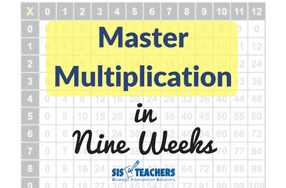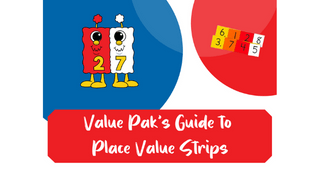Today, schools seem to place so much pressure on students to be able to do “fast facts.” Schools are giving out awards and incentivizing the memorization of facts with things like ice cream parties where students are only allowed to get a certain amount of ice cream or toppings based on the groups of facts they know.

But faster isn’t always better, and it isn’t necessarily smarter. It definitely isn’t helping students develop a true depth of knowledge or foundation of number sense they need when it comes to multiplication.
The real question is: What is fluency?
Let’s look at two scenarios:
One student looks at 7 x 7 and can immediately say 49.
Another student looks at 7 x 7 and says, “Well, I know that 7 x 5 is 35 and 7 x 2 is 14, and if I add 35 and 14, I know the answer is 49.”
Which student is more fluent?
At Strategic Intervention Solutions, fluency doesn’t mean fast. It means accuracy and efficiency.
We need to spend more time helping students learn multiplication. We need to help students discover the patterns in the numbers, because these will come up again when we look at more advanced concepts further down the road such as prime and composite numbers, fractions, square numbers. When we rush through instruction, kids miss those foundational patterns.
Fluency for multiplication and division should be developed by the end of third grade, not the beginning. However, within the first month of school, we’ll see schools giving timed math fact quizzes, thinking that faster is smarter. In a third grade classroom, we typically do arrays. We talk about rows and columns, we talk about area, but then all of a sudden – boom – we have multiplication and fact sheets. But at the end of the day, if kids don’t have a reason why they know what they know, they don’t actually have an understanding at all.
 In our project schools, third grade uses our multiplication journals every single year as a consumable. In schools where math fact knowledge is low (which is everywhere!), we’ve had teachers use these with third, fourth, and fifth grade, and then every subsequent year in the third grade.
In our project schools, third grade uses our multiplication journals every single year as a consumable. In schools where math fact knowledge is low (which is everywhere!), we’ve had teachers use these with third, fourth, and fifth grade, and then every subsequent year in the third grade.
By working through the multiplication journals at the blazing speed of nine whole weeks, you can truly expect magic to happen with your students’ multiplication fact knowledge. But it’s not really magic, it’s methodical. By presenting math facts to students in a the logical order suggested by the math journal, students have an opportunity to see patterns and relationships between the numbers instead of just memorizing facts.
The suggested sequence to teach the facts is: 10, 5, 2, 4, 8, 3, 6, 9, 7. As students slowly work through their multiplication journals, they can discover the connections between multiplying by 10 and 5; 2, 4, and 8; 3, 6, and 9; and finish up with 7. Multiplying by seven is usually the most challenging. For example, 7 x 7 might be hard for students, but if they know what 7 x 5 is and 7 x 2 is, they can decompose 7 into 5 and 2 and come up with the answer.
We want you to go slow to go fast. This multiplication journal gives you a plan for exactly what that looks like.
On day 1, students go through and skip count with the number they’re focusing on. If they’re doing fours, they’ll be skip counting by four, but looking at the patterns that they saw when they were counting by twos, and they’ll also look at the eights on the same grid. I like to have students use an abacus on this day and actually push the beads across to make their groups of four. They color in the squares not to fly through the activity, but to look for patterns in the collections of numbers. Then, they make observations like, “I notice that these numbers are all even,” “I notice that on one row we colored in two and another row we colored in two,” “I noticed that we’re using every other decade number when we’re doing this.” Getting kids to see what the patterns are within four in how they relate to two and eight is our focus on this day.
The 2nd day is equation day. Students are doing their facts and writing out equations. “Zero groups of four is zero. One group of four is four.” They continue doing this all the way to 40 groups of four. Then, we can have students think about their groups of four. You might ask, “If I know that 40 groups of four is 160, I wonder what 38 groups of four is. Talk to your partner about how you would know what that might be.” Kids might say things like “I knew that 40 groups of four is 160, so if I go back a group of four and another group of four, I can figure that out.”
On Day 3, students make area models. Students color their grids to make one group of four. When they rotate the page, they can say it’s four groups of one. And they continue to color their groups of four and manipulate the book to see the commutative properties of their models.
Day 4 involves using Math Practice #2 as students make a real life story about their groups of four. There are three levels of stories that we want students to create. They create a story with [a number] times four. Level 1 stories would be with a single digit times four: “I need five groups of four people to line up.” A partner can solve that problem and draw a model drawing. Level 2 is anything up to 99 groups of four, and Level 3 involves a three or four digit number times four.
Day 5 is extension day. One of the fun things we do is Multiplication Bump. Students skip count forward and backward on the abacus by fours (or whatever the focus number is). They push beads across in sets of four until they get to 40 and they can see the patterns as they’re going. Then they go backwards, “40, push four back, read the beads, 36, push four back, 32.” All the way back to zero, connecting the patterns they see. Number Bond Cards are a great option here as well. Students can go to the Math Salad Bar and get all the number bond cards that involve the fours.
We are also encouraging teachers to have students create a Fact Flap Card on this day. On the back page of the journal, students glue in a manila envelope that fits a 5×7 index card and students create the fact card for their focus number. These Fact Flap Cards are a great space saver because one card holds all the multiplication and division facts for a number, so it condenses 20 flashcards into one! And once they’re created, students can pull these cards out as needed for reference. (Want to see a sample? I make one for you to see in this Facebook Live Video we did last fall!)
These multiplication journals are an invaluable resource for students and schools are ordering them every year so every student has an opportunity to go through this process and develop a deep understanding of multiplication. Strategic Intervention Solutions is the sole provider of the journals, and I’m so excited to be able to offer these multiplication journals to our schools because I believe in them. Teachers in our Math Initiative schools who have taken the time to work through these journals over a nine-week period are reporting incredible results and are blown away at the depth of understanding their students are displaying around multiplication!
Get a set of journals, give it nine weeks, and see what happens with your students!



